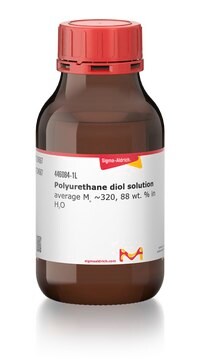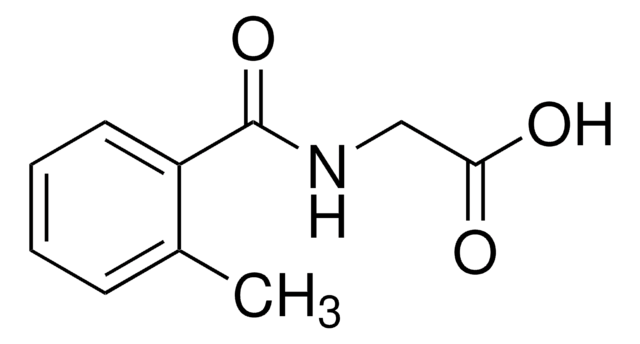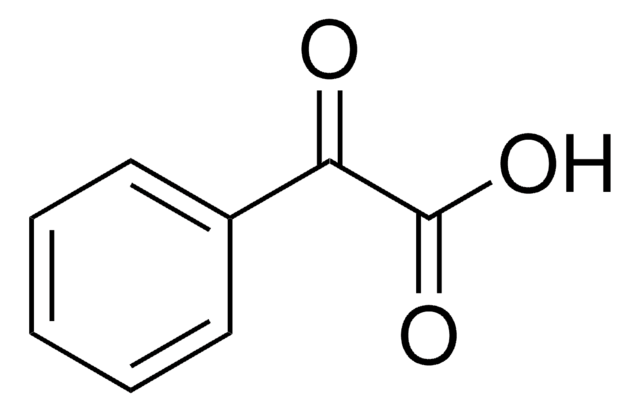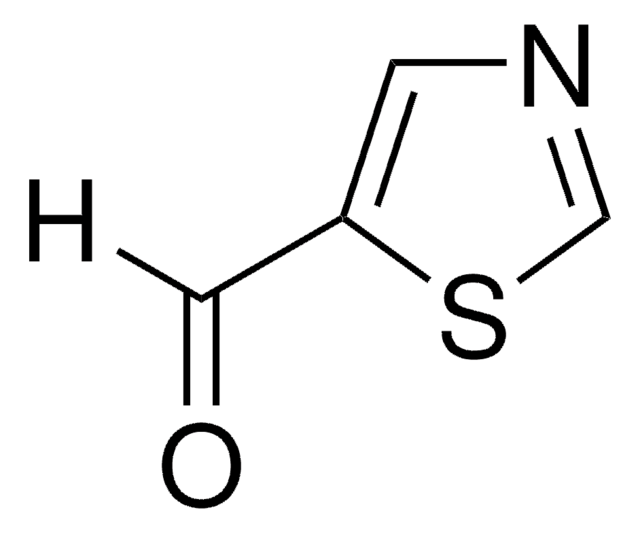430218
Poly[4,4′-methylenebis(phenyl isocyanate)-alt-1,4-butanediol/di(propylene glycol)/polycaprolactone]
pellets, MDI-polyester/polyether polyurethane.
Iniciar sesiónpara Ver la Fijación de precios por contrato y de la organización
About This Item
Productos recomendados
abrasion resistance
10 mg (Taber, H-22 wheel)
Quality Level
form
beads
pellets
melt index
4 g/10 min (190°C/8.7kg)
hardness
84 (Shore A, ASTM D 2240)
transition temp
Tg −40 °C (DSC)
softening point 85 °C (Vicat, ASTM D 1525)
density
1.18 g/mL at 25 °C (lit.)
General description
Poly[4,4′-methylenebis(phenyl isocyanate)-alt-1,4-butanediol/di(propylene glycol)/polycaprolactone] (PU/PCL) is a polyurethane solution that can be used as a shape memory polymer and a reinforcing unit for enhancing the mechanical and thermal properties of the base materials. It is biocompatible and finds usage in endothelial proliferations. PU/PCL contains polycaprolactone (PCL) that facilitates the hydrophobic properties of the polymeric matrix.
Application
Automotive fascia, cable jackets, side trim, fabric laminates, health care tubing, catheters, transdermal patches and in seals casters, shoes, bushings and wheels.
PU/PCL can be used in the formation of a polyurethane membrane for effective gas separation. It can also be used to synthesize reinforced hydrogel with good thermo-mechanical properties for biomedical applications.
Features and Benefits
Tough, high-performance, wear-resistant elastomer with good clarity, chemical resistance, flexibility and toughness. Can be used in current form or further polymerized. Low compression set
signalword
Danger
hcodes
Hazard Classifications
Acute Tox. 4 Oral - Eye Irrit. 2 - Resp. Sens. 1 - Skin Irrit. 2 - Skin Sens. 1
Storage Class
11 - Combustible Solids
wgk_germany
WGK 3
flash_point_f
Not applicable
flash_point_c
Not applicable
Elija entre una de las versiones más recientes:
¿Ya tiene este producto?
Encuentre la documentación para los productos que ha comprado recientemente en la Biblioteca de documentos.
3D Networked Graphene-Ferromagnetic Hybrids for Fast Shape Memory Polymers with Enhanced Mechanical Stiffness and Thermal Conductivity
Lee S, et al.
Small, 10(19), 3880-3886 (2014)
Strong fiber reinforced hydrogels for biomedical applications
2011 IEEE 37th Annual Northeast Bioengineering Conference (NEBEC), 9(2), 1-2 (2011)
Gas separation in mixed matrix membranes based on polyurethane containing SiO2, ZSM-5, and ZIF-8 nanoparticles
Amedi HR and Aghajani M
Journal of Natural Gas Science and Engineering, 35(19), 695-702 (2016)
A hybrid electrospun PU/PCL scaffold satisfied the requirements of blood vessel prosthesis in terms of mechanical properties, pore size, and biocompatibility
Nguyen T, et al.
Journal of Biomaterials Science. Polymer Edition, 24(14), 1692-1706 (2013)
Mélusine Bouchet et al.
Materials science & engineering. C, Materials for biological applications, 100, 715-723 (2019-04-06)
The search for novel, more compliant vascular grafts for the replacement of blood vessels is ongoing, and predictive tools are needed to identify the most promising biomaterials. A simple analytical model was designed that enables the calculation of the ratio
Nuestro equipo de científicos tiene experiencia en todas las áreas de investigación: Ciencias de la vida, Ciencia de los materiales, Síntesis química, Cromatografía, Analítica y muchas otras.
Póngase en contacto con el Servicio técnico










